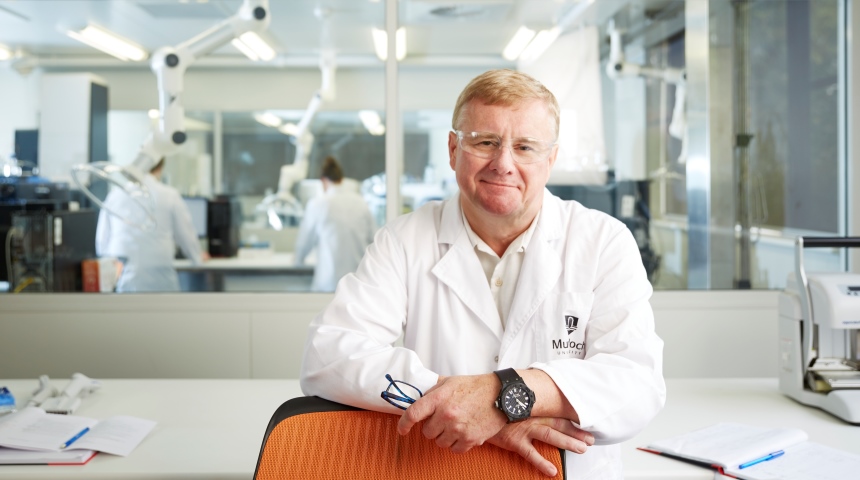
A game-changing new research centre, led by Murdoch University, promises to transform the treatment of disease and improve the health of millions of people in Western Australia and beyond.
World-leading phenomics research at the Australian National Phenome Centre (ANPC) is set to revolutionise the diagnosis, prevention and precision treatment of a multitude of medical conditions including cancers, obesity, autism, dementia and type 2 diabetes in individuals and, on a larger scale, across communities. Its benefits are not limited to human health, but can also be used to unlock new discoveries in areas such as animal health and agriculture.
A person’s phenome is a snapshot of their unique biology resulting from the complex interactions between environmental factors such as their diet, lifestyle and exposure to pollutants, and their genes. Analysing these biological “fingerprints” helps researchers better understand the underlying causes of disease and to develop personalised treatments to prevent and treat it.
Using the ANPC’s sophisticated technology, researchers plan to map the phenomes of the entire population of Western Australia, giving them a window into environmental and social factors influencing health trends and providing generations with a crystal ball into their future health risks.
The insights will inform the development of community health prevention programs and policies, building on the State’s strong global reputation for population health studies such as the Busselton Health Study and the WA Pregnancy (Raine) Study.
Internationally-renowned pioneer
Internationally-renowned pioneer in systems medicine and metabolic phenotyping Professor Jeremy Nicholson, who as Pro Vice Chancellor of Health Sciences at Murdoch University will lead the ANPC, said priority study areas for this visionary project would match with health issues facing Australia and the world.
“We will be looking at a range of major diseases to determine the genetic and environmental origins and new interventional paradigms for prevention and treatment,” Professor Nicholson said. “We are proud to play a key role in what will be a scientific revolution for Australia that will also create international impacts.”
Distinguished computational biologist Professor Elaine Holmes, who is the 2018 WA Premier’s Fellow in Phenomics, will join Professor Nicholson at the ANPC, as will Dr Ruey Leng Loo as the Premier’s early-career fellow.
With a steady population of around 2.5 million and existing strengths in health data and long-term population health studies, Western Australia is ideal for a phenomics study of this scale, Professor Holmes said.
“Electronic health records combined with the technology we have at the ANPC will help us to process huge numbers of samples over the course of five to 10 years, mapping the health of a generation of Western Australians,” she said.
Murdoch Vice Chancellor Eeva Leinonen said the University was proud to be leading the ANPC project, a major investment into the health and wellbeing of the WA community and beyond.
“Through this collaborative project that brings together world-leading researchers and the expertise of all WA universities, major hospitals and medical research institutes, we are hoping to transform the way people are diagnosed and treated for diseases and health conditions in WA and around the world,” Professor Leinonen said.
“This high impact research has the potential to change the lives of billions as it is applied to address some of the world’s greatest challenges in the health and medical sphere as well as in food production and the discovery of new drugs to treat illness.”
WA Health Minister, Roger Cook said: “We are excited about the impact that the addition of Jeremy, Elaine and Ruey will have on precision health, but more so on the broader areas of health and medical research and healthcare in WA.
“Having access to established academic superstars like Jeremy and Elaine and emerging talent such as Ruey, will help drive WA’s competitiveness in a wide range of aspects of health and medical research and will ultimately lead to better health outcomes for Western Australians.
“Targeted, personalised medical treatment not only results in a more efficient health system but most importantly delivers more effective treatment for patients. Having researchers of this calibre in WA aligns with the McGowan Government goal to continue to build WA as a global hub for medical research and innovation.”
Learn more about phenomics with Professor Nicholson, who will be delivering the prestigious Sir Walter Murdoch Lecture at Murdoch’s Perth campus on Wednesday 7 November.
Background
The ANPC is proposed to be based at the Harry Perkins Institute (South) and will have the largest collection of mass spectrometers in the Southern Hemisphere.
It is designed to match technologies with other phenome centres in Singapore, Hong Kong, Birmingham and London. The data collaboratively produced will help researchers understand population health trends, and identify subtle environmental or cultural variations that influence disease susceptibility and recovery.
Supported by the State Government and the Australian Research Council, the centre is a core platform of the Western Australian Health Translation Network (WAHTN), which brings together expertise from all Western Australian universities, major hospitals, medical research institutes and partners. These include the Telethon Kids Institute, the Harry Perkins Institute of Medical Research, the Pawsey Supercomputing Centre in Perth and the EPICentre at the University of New South Wales.